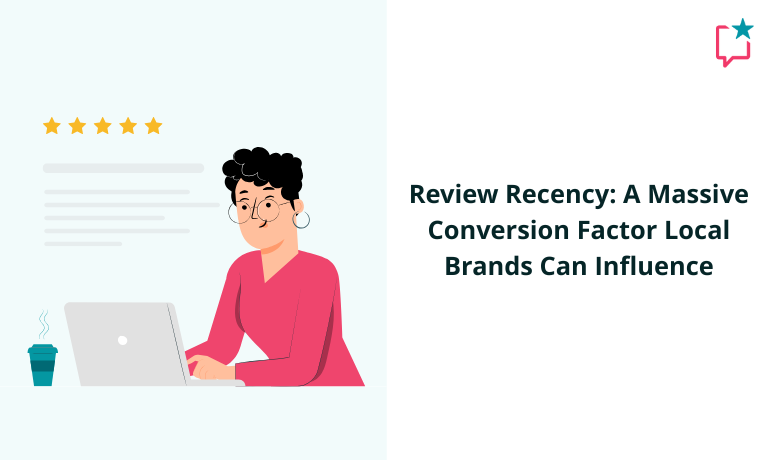
Want to boost Google Business Profile clicks, conversions, and sales? Average Google Business Profile (GBP) star ratings make lots of local search marketing headlines for good reason, but the less-flashy-sounding factor of review recency turns out to be a major influencer, according to the 2025 edition of GatherUp’s consumer review survey, Beyond the Stars.
This annual survey of 1000+ US adults reveals how your potential customers are prioritizing the different components of reputational information in your GBPs to make a decision about whether or not to choose your brand for a transaction. This data is worthy of a deeper dive, which we’ll take right now.
Quantifying the impact of review recency on local consumer behavior

The reviews section of Google Business Profiles offers multiple attention-grabbing signals, including:
- The average star rating
- Total review volume
- Place topics, summarizing words mentioned most often by reviewers
- Filter tabs for sorting reviews by most relevant, newest, highest, and lowest
- Individual reviewer profiles, including avatar, name, status like “Local Guide”, the number of reviews written, and the number of photos uploaded by the reviewer
- Individual star ratings
- Timestamp of the review
- Review text content
- Photos/videos included in the review
- The ability for others to “like” the review via a heart icon
- The ability to copy the review link or share it socially
- Owner responses
With so many reputational components competing for the Google user’s attention, GatherUp wanted to know which element consumers pay attention to most.

Finding: Review recency is more influential than average star rating
While 22% of consumers say that the average star rating is the reputational element that earns their primary focus, that number doubles when it comes to review recency. It also far outpaces both looking at lowest-rated reviews first or any other factor.
If 44% of customers are most influenced by your brand’s most recent review content, it’s clear that it deserves your priority attention, too.
Does the influence of recency make good common sense?
Yes, it really does. Consider these three scenarios:
Scenario 1: A customer enjoyed dining at a family-owned Mexican restaurant a couple of years ago. They have good memories of the friendly service, family atmosphere, decent pricing, and delicious food. Now, a friend is coming to town and they want to take them out for a really nice informal meal, but because it’s been a while since they ate at this establishment, they do a little research to be sure the restaurant is still providing a quality experience. In looking at the most recent reviews, they discover that the restaurant changed ownership in the interim, raised its prices, and is receiving quite a few complaints about rude staff and bland food. Review recency just saved this customer from treating their friend to an experience neither of them would probably enjoy.
Scenario 2: A patient sees a dentist for an annual teeth cleaning, but when they phone to make this year’s appointment, they don’t recognize the voice of the receptionist, who treats them rudely, making it sound like a hassle to schedule their visit. Curious, the patient brings up the most recent reviews for the practice and learns that lots of peers are mentioning that the business has brought aboard a new office management staff. Multiple patients are complaining of an unfriendly atmosphere that is adding to the normal stress of having dentistry. Review recency just signaled to this patient that it might be time to look for a new dental care provider.
Scenario 3: A traveler is planning to visit a variety of small towns on the coast of California on their vacation, and especially wants to stop at local history museums. In planning their trip, they are looking at places on Google Maps to add to their itinerary. A museum on Cannery Row in Monterey looks like a fun destination, and the Google Business Profile for it says it’s open 7 days a week from 9 to 5. However, in scanning the reviews for the museum, the traveler realizes that the location has been closed for the past 3 months for renovations. Unfortunately, the listing owner didn’t update their open/closed status on their listing. Review recency just saved this vacationer from a wasted journey and disappointment.
In sum, consumers’ priority focus on reviews makes good sense because they provide the most current picture of significant factors like quality, trustworthiness, and accessibility.
But how recent does a review need to be for consumers to consider it relevant?

Finding: Your brand’s review influence has a shelf life
54% of consumers say that a review must be a month-or-less old for it to impact their decision in choosing a local business. An additional 27% consider reviews from the past 6 months to be relevant. Just 10% are influenced by reviews from the past year and an additional 10% state that the age of a review doesn’t matter to their deliberations.
If a combined 81% of your potential customers are dependent on reviews that have been written in the past 6 months or less, review freshness deserves premium focus amongst the metrics you are tracking in your local search marketing campaigns.
Does the recency timeframe make sense?
Yes. The 24% of consumers who say they only pay attention to reviews that have come in in the past week or so display the highest degree of awareness of how quickly local commercial landscapes change. Consider some factors that could change overnight and affect the customer’s experience:
- Temporary or permanent business closure
- Emergency conditions
- Mergers, acquisitions, and new management
- Supply chain problems
- Product recalls
- Quality control fluctuations
- Hiring of new staff
- Change of location
- Change of hours of operation
- Change of phone number
- Change of menu or inventory
Consumers are right to check the most recent reviews, because they are protecting themselves from unwelcome surprises, frustrations, and wasted time.
How to improve local business review recency

It can take so much effort to earn reviews, and while all the reviews your business has received since your Google Business Profile launched continue to impact its average star rating, the influence of individual reviews on conversions degrades over time. Like a perishable product, your reviews have a shelf life and have to be replaced with fresher offerings.
Because of this, the signal your local business needs to zoom in on is review velocity.
You need to be earning an ongoing stream of fresh review content week over week, month over month, and year over year. While some reviews will appear on your GBP spontaneously, you can absolutely increase your velocity with an active review acquisition campaign (GatherUp can help!)
Fortunately, our new survey enables us to offer you a data-based checklist for maximizing the rate of response to your review requests by honoring consumer preferences. Share this checklist with teams and clients:
- Ask for reviews via email; 53% of customers are fine with it
- Ask for reviews in person; 49% of customers are fine with it
- Ask for reviews via SMS; 33% of customers are fine with it
- Ask for reviews on print materials, like receipts and menus; 33% of customers are fine with it
- Ask for reviews at the time of service; 35% of customers prefer it
- Ask for reviews later that same day; 22% of customers prefer it
- Ask for reviews 1-3 days later; 19% of customers prefer it
- Ask customers to include photos and videos in their reviews; it increases trust for 32% of readers
- Ask customers to be detailed and specific about their experience; it increases trust for 60% of readers
- Display reviews on your website; it increases trust for 19% of readers
- Don’t engage in review fraud; it’s illegal and 51% of the public will avoid your business if your profile gets stamped with a spam warning
- Follow up with review request reminders; forgetfulness is the #1 reason people don’t write more reviews
- Invest maximally is customer service; 67% of the public write positive reviews to reward great experiences
A combination of the right review request methodology, the right timing, specificity in requesting feedback details + trust signals like reviews and videos, adherence to review platform guidelines + laws, sending follow-up reminders, and prioritizing excellent customer service should directly, positively impact review velocity.
It’s also great to know that many local SEO experts strongly believe that review recency/velocity impact your Google local pack and Maps rankings. So, by improving review freshness, you’ll also likely improve your visibility to potential customers, increasing discoverability and conversions. This, then, creates a virtuous cycle in which fresh incoming customers will write fresh incoming reviews…if you remember to ask!
But this is just the tip of the iceberg (lettuce!)
Today, we’ve seen why customers are smart to focus on review recency that acts like a weather report on business conditions right now. Because the influence of reviews wilts over time, an always-on review acquisition campaign is the best solution for maintaining review content freshness.
But review recency is just one factor with a major impact on consumer behavior and brand profitability. You need to know how AI is impacting local customer journeys, how aware the public is on the problem of review fraud, which reputation platforms are most trusted by consumers, what negative reviewers want from your business, and so much more. Get all the answers so you can create a reputation management strategy based on some truly fresh data.
